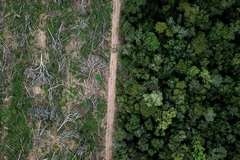06 Apr 2016 --- During the first half of fiscal year 2015/16 (ended February 29, 2016), the Barry Callebaut Group have increased its sales volume by 4.5% to 933,327 tonnes, significantly outperforming a slightly improving but still weak global chocolate confectionery market.
This volume growth was driven by the chocolate business across all regions. All key growth drivers contributed positively and in the Global Cocoa business, sales to third parties were intentionally reduced and less profitable contracts are being progressively phased out.
Sales revenue grew by 11.7% in local currencies to $3,565,15 million, driven by higher cocoa bean prices compared to last year and increased sales of higher value products.
.jpg)
Gross profit increased by 4.7% in local currencies to $455.95 million, largely in line with volume growth as the negative impact from the combined cocoa ratio was compensated by a good development on margins and a better product mix in the Group’s chocolate business due to the strategic focus on this area.
Antoine de Saint-Affrique, CEO of the Barry Callebaut Group, said: “We have achieved solid results despite very challenging market conditions. Our volume growth shows a consistent, strong performance. Our bottom-line reflects the predicted negative impact of the weak cocoa products market and a significant negative currency translation effect. Our focus on ‘smart growth’ is gaining traction.”

Victor Balli Chief Financial Officer of the Barry Callebaut Group said: “We didn’t only have a solid growth but we had the right type of growth which contributes positively to our performance, we achieved double digit volume growth in emerging markets across all regions and this is very much in line with our ambition.”
Speaking at a conference held earlier today, Saint-Affrique explains the cocoa market is defined by the combined ratio of the pricing of powder and butter: “Last year for the first time in twenty years it was at a very low level, the conditions of the cocoa market has an impact on the entire industry. We see this combined ratio coming back step by step we have taken some drastic measures to be more indefinite of the combined ratio, but this is a long term journey.”
Balli added: “Slowly we see a growth in the cocoa powder market, we have shut down capacity, the whole market situation has started to improve and become more disciplined but its still too early say but it is going in the right direction.”
“Naturally by growth of our cocoa business without investing further into capacity our third party cocoa sales will decline. Normally we would be concerned but actually we can become more selective,” claims Saint-Affrique.
Compared to the strong comparison base from last year, operating profit (EBIT) was almost flat at $208.98 million (-0.3% in local currencies and -8.4% in CHF, due to a significant negative currency translation effect of -$18.64 million resulting mainly from the strength of the Swiss franc against the Euro and some emerging market currencies). As anticipated some restructuring costs related to the Cocoa Leadership project and additional investments in Sales and Marketing also had a negative effect.

Net profit was down -12.5% in local currencies (-18.5% in CHF) to $112.33 million, affected by higher financial expenses, income taxes, and foreign exchange effects.
Net working capital decreased by 11.8% from $1,631.06 million in the prior year period to $1,439.13 million despite the Group’s growth. This is mainly the result of the Group’s working capital initiative leading to significantly lower volume in inventories and an increase in trade payables and other current liabilities.
Net debt amounted to $1,601.40 million, down by 14.1% from $1,864.17million in the prior year period. The decrease was mainly driven by lower financing needs related to working capital and capital expenditure.
As a result, free cash flow significantly improved to $229.45 million whereas the prior year period resulted in an outflow of -$148.69 million.
Strategic milestones in the first 6 months of fiscal year 2015/16
“Expansion”: Barry Callebaut closed the acquisition of the commercial beverages vending activities of FrieslandCampina Kievit, making it a leading supplier of vending powder mixes. Barry Callebaut also signed outsourcing agreements with two local players in Eastern European markets, proving the potential of outsourcing in emerging markets.
“Innovation”: Barry Callebaut “crafted and co-created” the chocolate experiences of tomorrow with its customers at the important trade shows FIE in Paris/France and ISM in Cologne/Germany and presented three product novelties: Caramel Doré (premium Belgian caramelized chocolate), Choc37.9 (heat-resistant) and Happy Chocolate (with proven health benefits).
“Cost Leadership”: Barry Callebaut completed the announced downsizing of its cocoa manufacturing footprint in Asia (Thailand and Malaysia) as part of the Cocoa Leadership project and continues to bundle transactional activities across Europe in its Shared Service Center (SSC) in Lódz/Poland and to further expand it.
"Sustainable Cocoa”: In response to growing customer demand for sustainable and traceable ingredients, Barry Callebaut switched the production of Crema dell’Artigiano and Tintoretto, two of its most popular fillings for bakery and confectionery products, from RSPO mass balance to RSPO fully segregated palm products as of January 2016.
Saint-Affrique adds: “We are winning the hearts and minds of chefs with our strong global network of chocolate centers and this is fundamental to the service of our food manufacturer customers. On the acquisition front we have successfully closed the acquisition of the beverage vending activity and as a result we are becoming a leading supplier of vending power mixes in Europe and we can already see what we can add in terms of technical innovation capabilities, which is a very strong business.”
by Elizabeth Kenward
.jpg)














